Pop quiz: What do all of these sites’ home pages have in common?
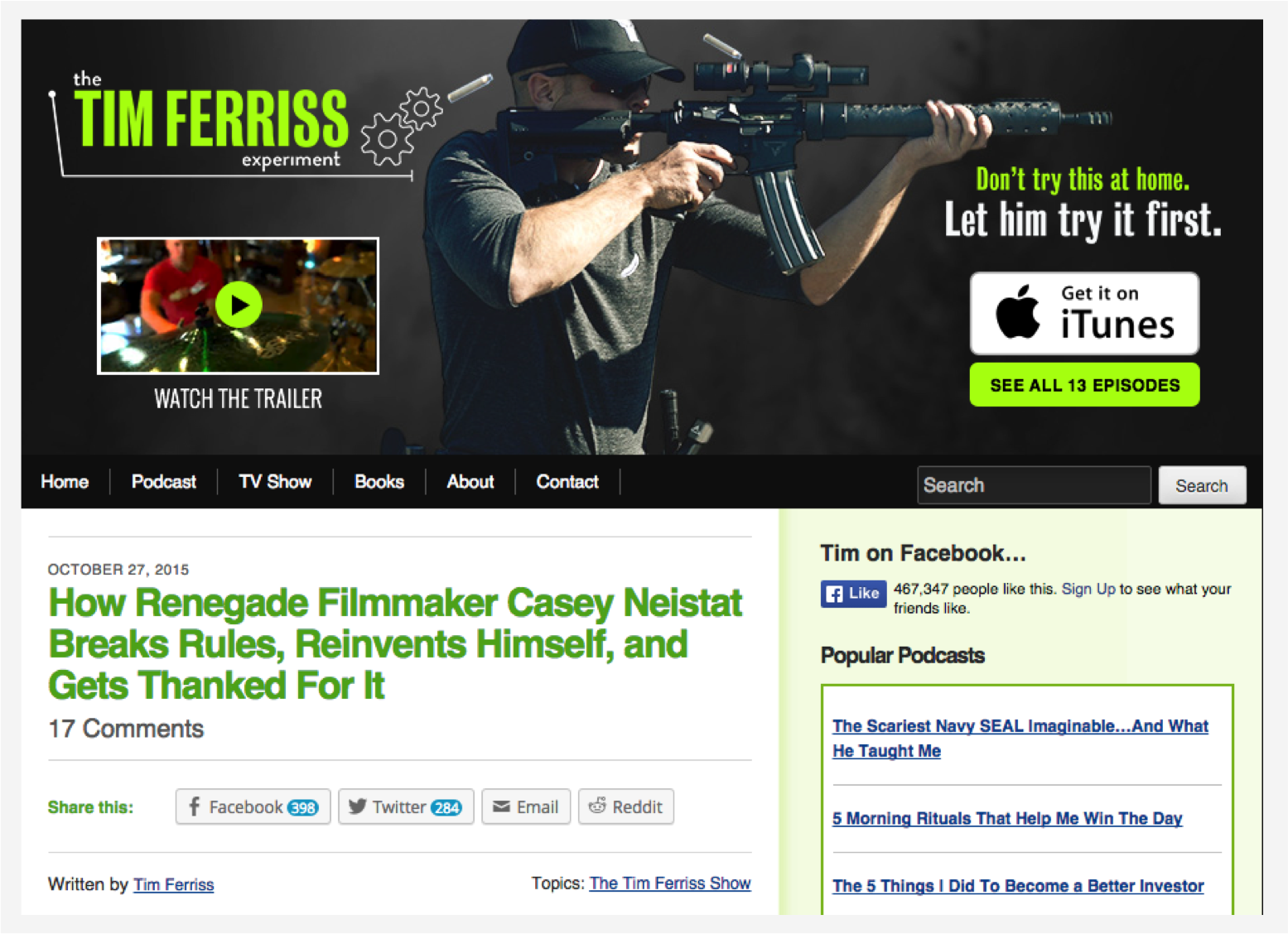

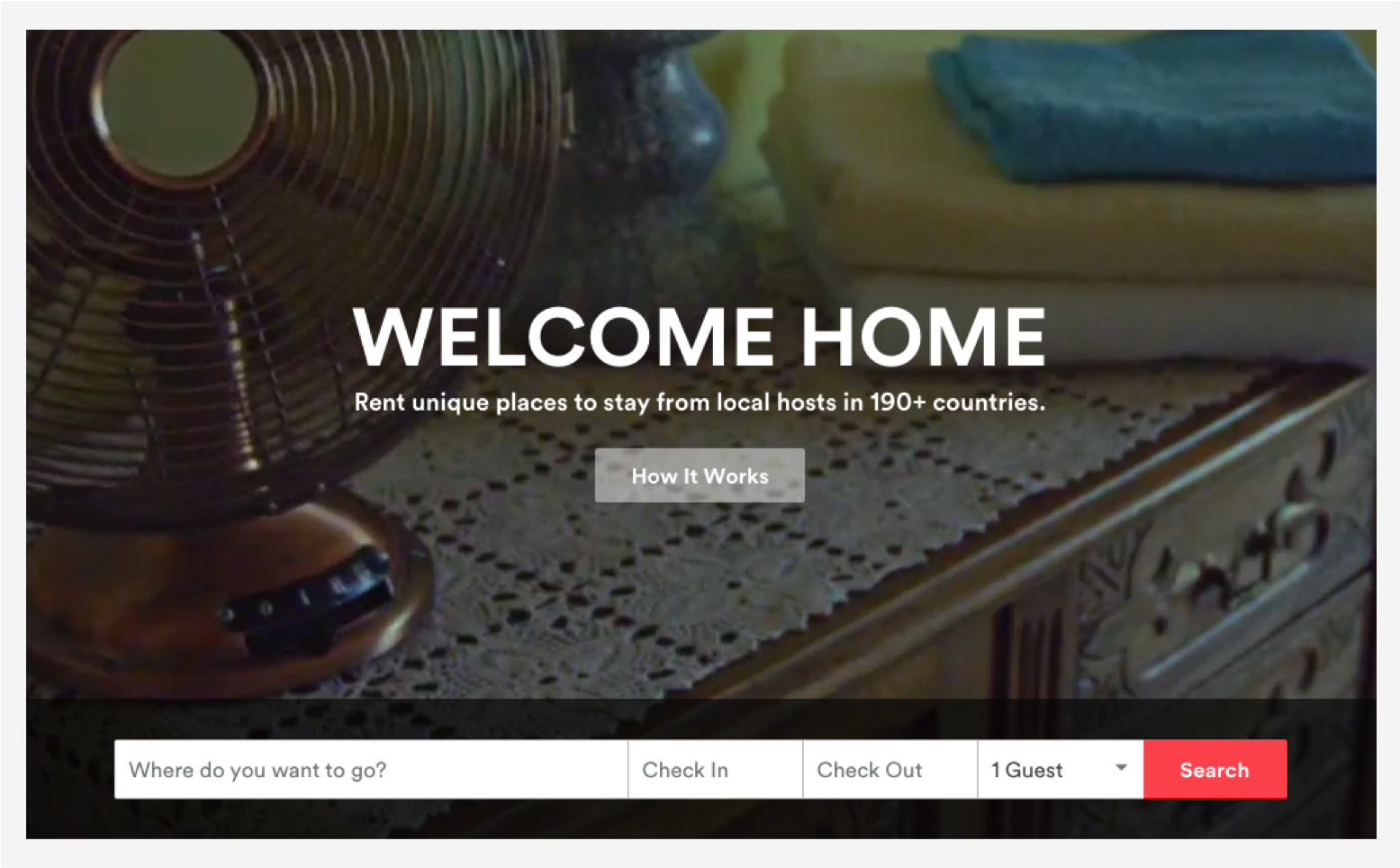
Okay, I admit, the title of the article is kind of a giveaway. They’re all using social proof to show you how big their reach is, immediately when you show up.
Tim Ferris displays how many people on Facebook like his posts to build social proof. Wait But Why shows you how big their email list is. Airbnb shows you just how many countries have active Airbnb hosts in them.
Imagine you’ve never heard of these sites. You show up for the first time, see some content or products, but how do you know that they’re legitimate and you can trust them?
We tend not to trust websites or brands… we’d rather trust our peers.
According to research done by Nielsen, 92% of people will trust a recommendation from a peer, and 70% of people will trust a recommendation from someone they don’t even know.
But ads, or other "paid" social proof? Less than 40% of people trust it.
If you want your website, sales page, email, or anything else to create immediate trust with a reader, you need to show them that other people are already on board.
Not convinced? Just adding testimonials, a very basic type of social proof (which we’ll cover) increases conversion on sales pages by 34%.
And have you ever noticed our site is COVERED in social proof? Here’s the center of our homepage (notice the 207,083):

And here’s one of our most effective Welcome Mats:

And we have testimonials on all of our product pages, like this one for our link-sharing app Discover:

Why do we have so much social proof? Because it works. We test everything we do, and social proof always increases our conversions.
So how can you use this strategy to make your own marketing more effective?
I dug far and wide and found every single option you have for adding social proof to your website, product, email popups, and more.
But don’t pick just one, see if you can include multiple in a way that lets them work together for even more benefit.
I’ll cover the 13 different types of social proof you can use, and within each one I’ll include some tips for increasing its effectiveness and give you some ideas for where you could use it on your site.
How to Use This Article
This is the only article on social proof you’ll ever need. But it’s way too much to do at once.
Instead, here’s what I recommend.
- Read or skim through this article, then print it out and save a link to it.
- Pick one or two types of social proof that look interesting.
- See how you can integrate it into your most important call to action (buy, signup, share, etc.). Start there.
- Watch how it affects your conversion rates.
- Come back and find your next one.
Ready to get started? Here are the 13 types of social proof you can use:
- Raw Quantity
- Celebrity & Expert Endorsements
- Testimonials and Quotes
- Where You’ve Been Featured
- Certifications
- Referrals
- Gazing
- Ratings and Reviews
- Case Studies and Proof of Concept
- FOMO: The Fear of Missing Out
- Social (Media) Proof
- Rankings
- Integrations and Platforms
1. Raw Quantity: How Many People Are Using or Engaging With You
One simple method of creating social proof is to simply show how many people are engaging with your product.
For example, Buffer mentions on its landing page that “Millions of marketers use Buffer.”

Mailchimp, a popular email marketing tool, takes it a step further by mentioning the number of users as well as how much they’re using the app:

The trick is to use numbers that are both impressive, and believable. You may have a tool that’s on enough sites to get 7,000,000,000 impressions, but if you say that “7,000,000,000 people have used our tool” you won’t sound like you’re being honest.
Tips for Using Raw Quantity
- Think big, but not too big. There will be a lot of numbers you can include. Go for a large one that shows activity, but not one that’s SO large people don’t buy it.
- Make it relevant to the CTA. If you want their email, tell them how many email subscribers you have. Want them to buy? Tell them customer numbers.
2. Celebrity & Expert Endorsements
As early as 1760, brands have been using celebrities to promote their products and convince skeptical consumers of their quality.
You see it with food and drinks:

Fitness:

And just about every other type of product from billion dollar businesses.
At first blush it might seem like this type of marketing is reserved for companies who can pay celebrities millions for their help, but you can use the same technique with experts in your field to a similar effect.
Celebrity and expert endorsements work off of the “Halo Effect.” When someone sees a brand or product being associated with or endorsed by someone they have respect or admiration for, those positive emotions extend to the brand as well.
But it works better with someone the viewer is familiar with. Celebrities are effective for big brands because they’re trying to appeal to millions of people. But when you’re a smaller company, with a more targeted audience, you can instead use people that audience trusts.
For example, Brian Dean’s blog, Backlinko, is a top resource for SEO advice and strategy. It doesn’t make sense for him to get a random celebrity to endorse him because they don’t know anything about SEO.
Instead, he has endorsements from Neil Patel of Quicksprout and John Jantsch, the author of Duct Tape Marketing. Both are industry experts that readers of Backlinko are likely to recognize.
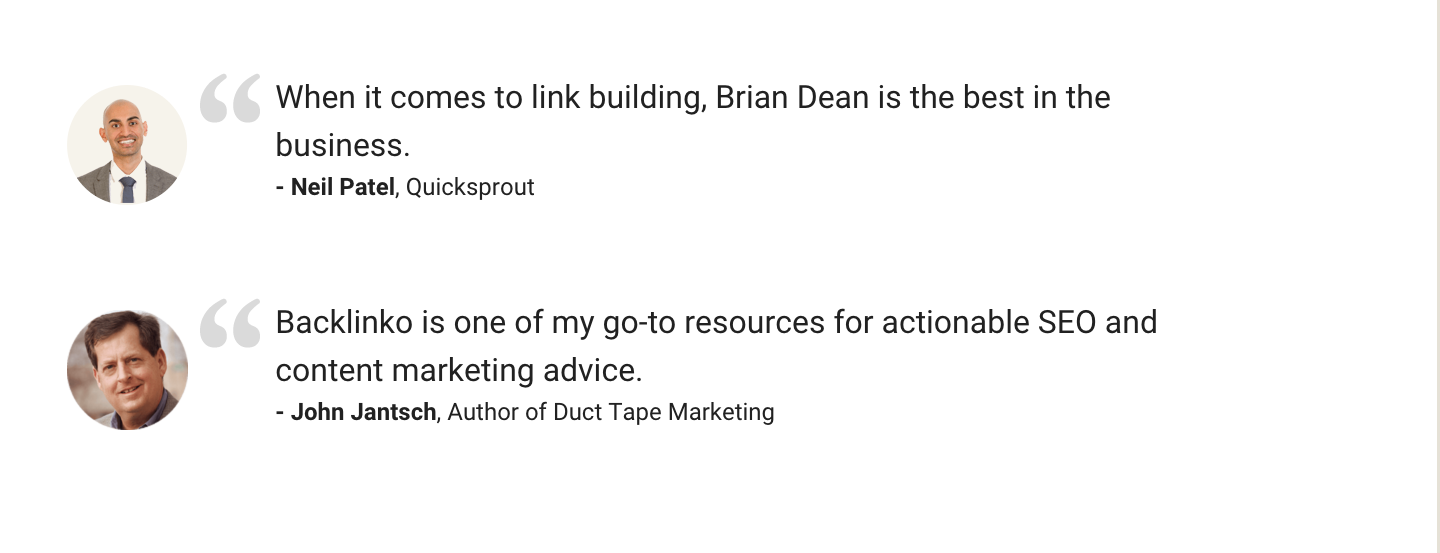
Or, if you go to Neil’s blog Quicksprout, he has an endorsement from Ben Huh, the founder of I Can Has Cheezburger (the site with all the silly cat photos)

In both cases, the endorsement adds to the site’s credibility, and makes you take what they’re saying more seriously.
Tips for Expert Endorsements
- Give it away. Is there a good expert or two that you could give your product away to in return for an endorsement? Reach out to them.
- Keep it relevant. The experts you look up to might be different from your customers. Try to target people that they’re interested in.
3. Testimonials and Quotes
The celebrity / expert endorsement are about getting credibility from thought leaders, experts, and trendsetters.
But another effective tactic is to get testimonials from people who are just like your average user, and who benefited from using your product.
For example, on the Teachable (software for creating online courses) home page, they show quotes and examples from normal people who have used their course creation software to start their own online business.
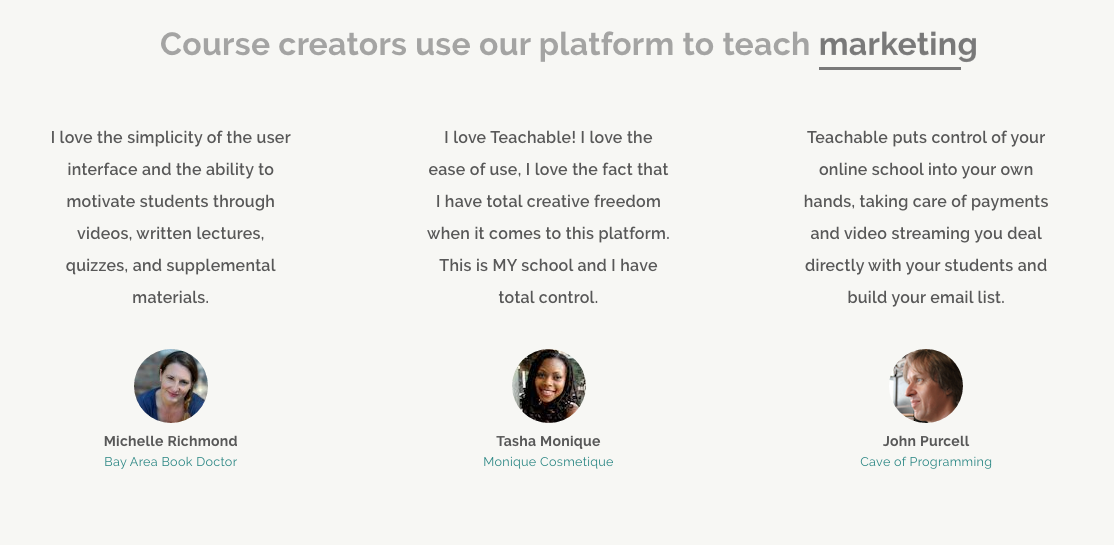
And if you go to Brennan Dunn’s course “Double Your Freelancing Rate” you can see that he has testimonial after testimonial from students who took it, along with how much they increased their rates.
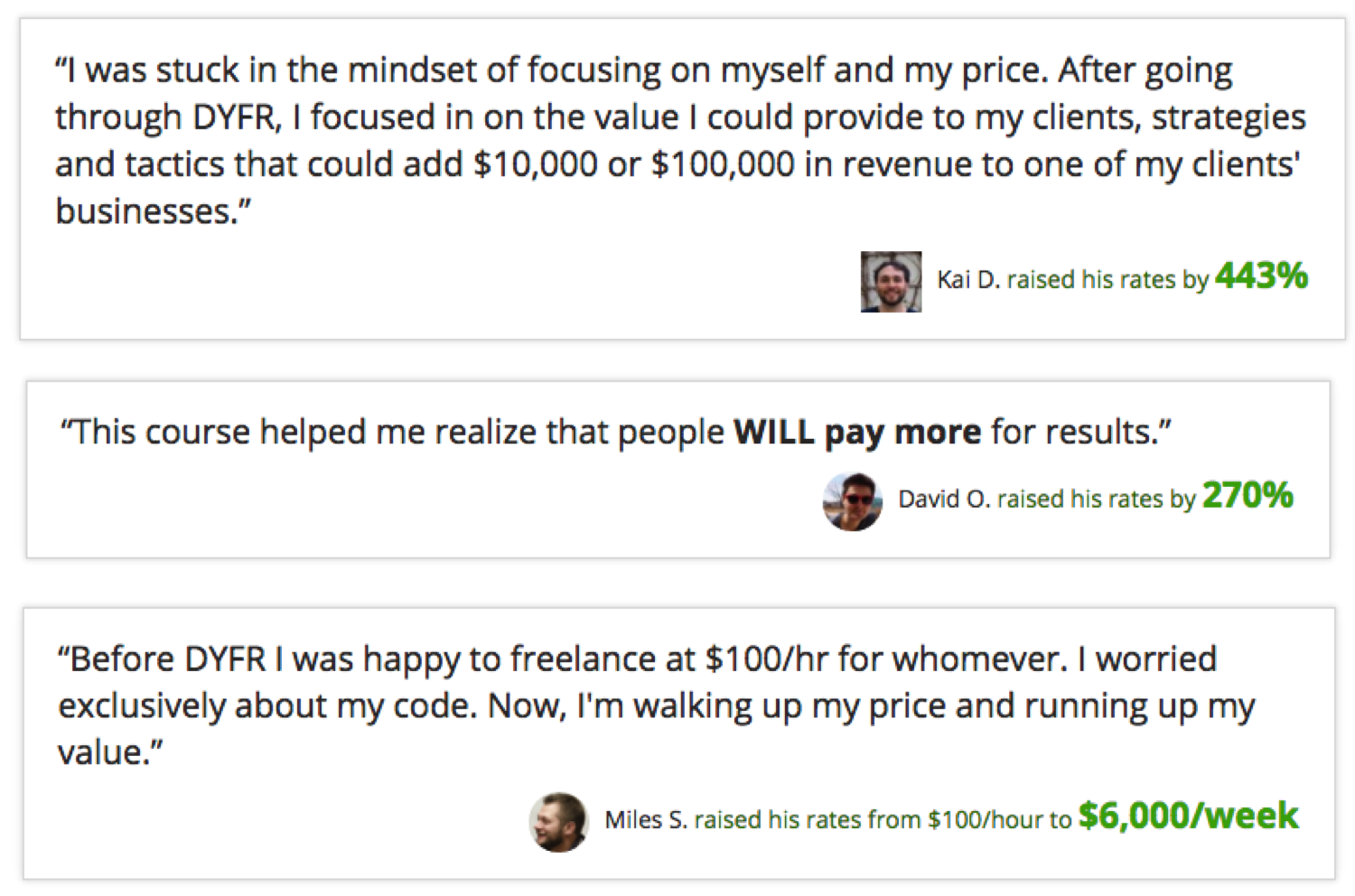
Testimonials like these WORK too. According to research done by Visual Website Optimizer, just adding customer testimonials on a product page can increase sales by 34%.
Tips for Testimonials
- Make it quantitative. Qualitative testimonials are fine, but testimonials with numbers that show how much you helped people go much further.
- Add pictures. Pictures make testimonials more trustworthy, so don’t leave them out.
- Get permission. People don’t always ask before using someone’s name in a testimonial, but it’s good practice to take the time to ask just so you don’t upset anyone.
4. Where You’ve Been Featured
Another popular strategy for authors, bloggers, or consumer products is to mention all of the places that you’ve been featured.
A feature could be anything, it could be:
- A quote
- A reference
- An article you wrote
- A time you were interviewed
- A link back to one of your posts
But having those big names on your site adds a lot of credibility to your work. Who would you rather take advice from, the writer who just has 10 posts on their page? Or the writer who has 10 posts on their page and who has been featured in Business Insider, INC, WIRED, and LifeHacker? Exactly.
Bryan Harris, founder of Videofruit, writes primarily about building an email list and web entrepreneurship. On his landing page, you can see some of the publications that he’s been featured in, lending to his expertise in these areas:
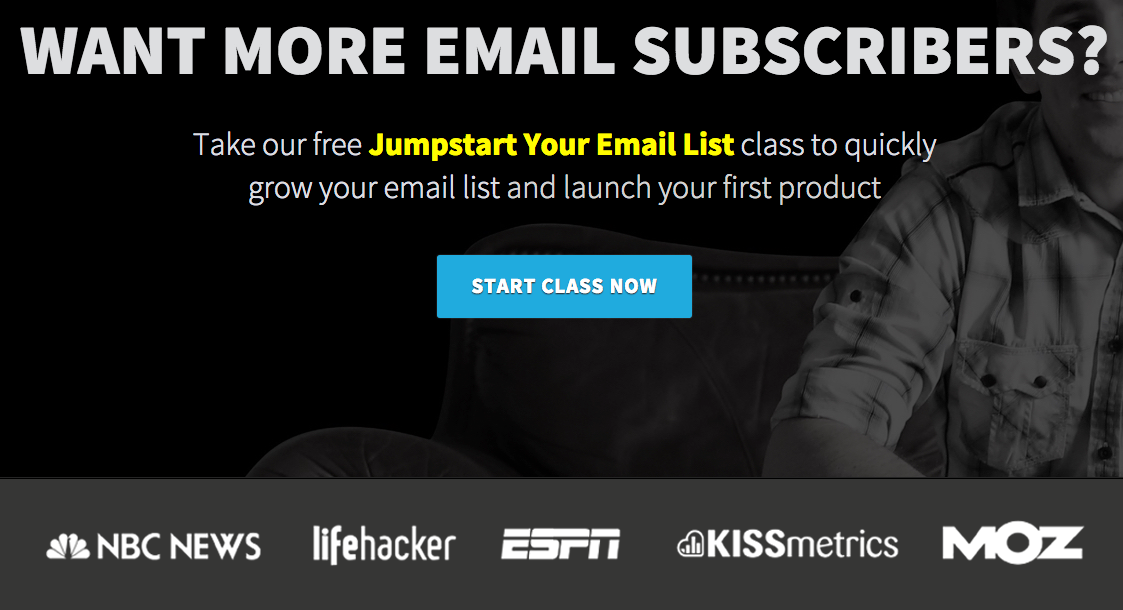
It’s a mix of big publications (NBC, ESPN) and then more niche ones that his Internet marketing audience will recognize (Kissmetrics, MOZ).
Paul Jarvis, a popular writer about being a successful freelance creative, uses a similar strategy on his homepage:

He mentions some of the top publications that he’s regularly featured in, and then promises that as an insider you’ll get early access to those articles before the public does.
Tips for Features
- Look for big sources. You may have been referenced on a big publication and not know it. Try using a tool like ahrefs or MOZ Open Site Explorer to see who’s linking to you right now.
- Feature the top ones. Focus on quality references over quantity. Think of your customer base, and then focus on having at least one source that represents each segment.
- Get featured more. Most importantly, get proactive about being included in big publications you’d want to have included on your site.
5. Certifications
If you have a service business that operates in certain regulated areas, or if you’re a freelancer that could take courses to prove your legitimacy, then certifications are another method of providing social proof to potential customers.
On the top end, you have certifications from governing agencies like the SEC that help prove to your customers that you’re offering a reliable service.
If you go to the homepage of Wealthfront, a popular automated investing service, you can see at the bottom that your investments through them are protected by the FDIC:

In this case they’re legally required to have that before they can accept your money, but seeing that sort of social proof on a site (especially when you’re considering trusting them with your retirement) goes a long way towards converting new customers.
A less intense version of this is to get certified in a skill related to your field. If you’re a freelance marketer, you could get HubSpots Inbound Marketing Certification. If you pass, you’ll be able to include the certification on your resume and get a badge for your site.

Tests like these can help would-be employers get a sense of how experienced you are, and whether or not they should interview you or give you a test job.
Tips for Using Certifications
- The bigger the name, the better. No one will be impressed by a certification from an unknown company, what’s the highest-brand one you can go after?
- Join the network. Some certifications will have a network that goes with them on LinkedIn or elsewhere. Becoming a member is another way to signal to potential clients that you’re qualified.
6. Referrals
Recommendations from friends are far and above the #1 trusted source of advertising. People will trust their friends more than an expert, or a set of reviews, and certainly more than a paid advertisement.
The most obvious way to take advantage of this is to ask for referrals, usually with some sort of incentive for the referrer.
Fancy Hands gives you $15 towards outsourcing your life if you get one of your friends to also sign up for the service:
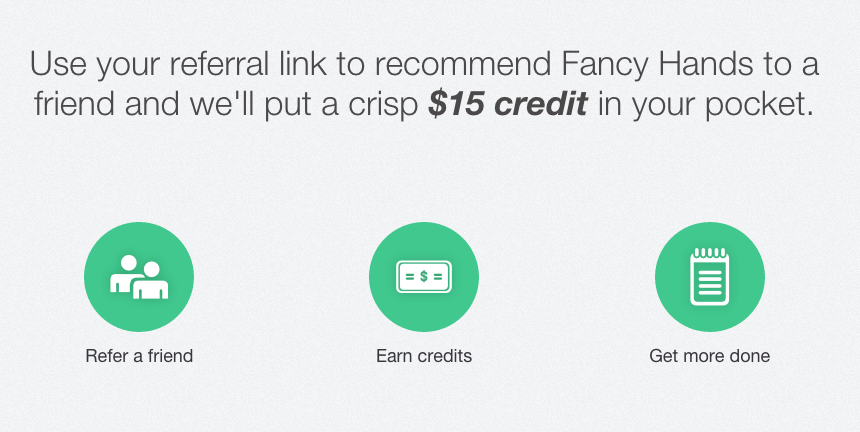
And we can’t forget the ever-cited famous example of this in technology, Dropbox, which gives you extra storage space for referring friends:
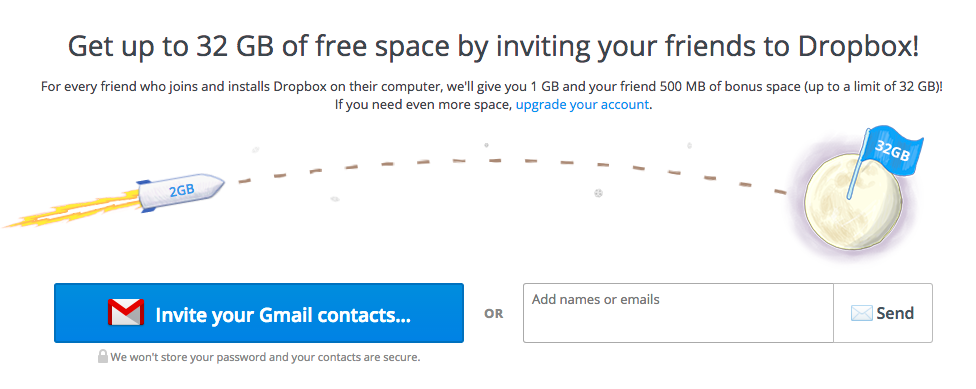
“Referrals” can be even simpler though. On many blogs, there will be a Facebook “Like” button and alongside of it all of the pictures of your friends that have liked that site. Such as this one on The 4-Hour Workweek Blog.
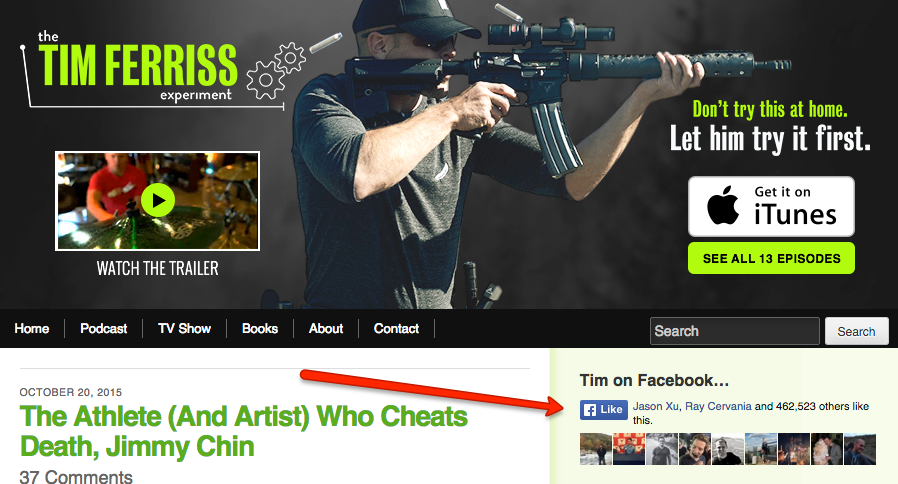
This is a type of referral since your friends are indirectly recommending the site, but Tim doesn’t have to do anything to get that referral. He just has to keep getting likes.
You can make it even simpler too. For our Traffic1M course, we ask you to refer a friend just by using a Click to Tweet button:

Tips for Using Referrals
- Make it personal. A referral from a friend or trusted source will go much further than a referral from a random person.
- Make it valuable. The best way to get your existing readers or customers to refer someone else is to make it worth their while. What can you offer in exchange for the referral?
- Make it easy. Can you pre-write the tweet, email, or text that they use to refer someone? That will make them much more likely to follow through.
7. Gazing
Social proof doesn’t always affect what we do, it also affects what we pay attention to. Depending on your site, or the page you want people to take action on, you can use a type of social proof called “gazing” to draw people’s attention where you want it.
When we don’t know where to look, we just look where everyone else is looking. And if there are no eyes to help us, arrows work fine as well.
So, quite simply, if you want people to take a certain action on your site, give them a pair of eyes and/or and arrow to help them out.
On Neville Medhora’s blog for his “Kopywriting Kourse” he uses a picture of himself staring right at the signup box to get people to opt in.
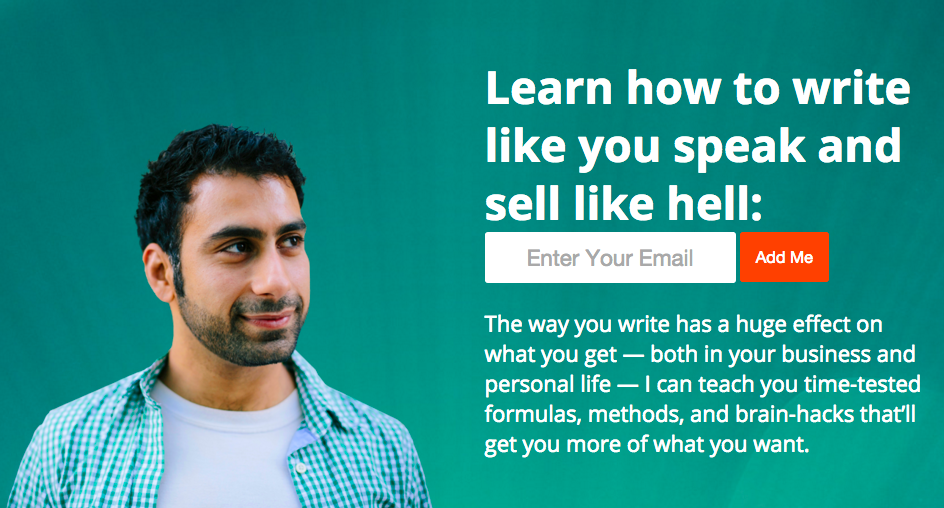
SnapEngage, a popular tool for live chat on your site, has their own spin on it. They have one (very small) person looking at you and pointing at the button to try their service, but then they also have a moving arrow directing your attention towards three of their key features.

However you decide to implement it, using a person’s eyes, as well as arrows, can help show your visitors or potential customers where they should be looking and focused on.
Tips for Using Gazing
To make the most of gazing as social proof in your marketing, keep these tips in mind.
- Use a familiar face. Someone that the reader knows, (e.g. a celebrity, expert, the writer of the blog) will have more social proof than a random stock picture.
- Make it big. Look at how big Neville’s picture is on his site. It takes over your visual stimulus and immediately points you where you need to go.
- Add some arrows. As long as it doesn’t look sketchy, add in an arrow pointing your visitor to where you want them to focus.
- Don’t confuse them. Multiple faces looking in different directions, arrows pointing multiple places at once, or having people look somewhere else than where you want the focus will all confuse your readers.
8. Ratings and Reviews
I mentioned before that the most trusted source of advertising was recommendations from friends.
What’s the second? Ratings and reviews.
Amazon knows this well. Their site features reviews and ratings above all else on product pages, because they know that when you have hundreds or thousands of people telling you that something is good then you’re much, much more likely to buy it.
It’s easy to see how effective it is. Would you ever want to buy either of these computers?

Okay, now what about these ones?

Even though you have no idea who these reviewers are, having that social proof can be the deciding factor on where you spend your money.
But maybe you’re not a marketplace like Amazon, or maybe you aren’t selling products on a site like Amazons. You can still reviews effectively.
On 99Designs, for example, they feature the average rating of the designers that you get matched to through their service:

Whatever you’re promoting on your site, if it’s something that you can get quantitate feedback from past customers on, feature it! And if that feedback is bad… well then improve your product!
Tips for Using Ratings and Reviews
- More is better. We take reviews more seriously when there are a lot of them. 10 5-star reviews? Maybe you paid for them. 1,000 4.5 star reviews? That seems legitimate.
- Make it detailed. When you get detailed reviews from people, they go much further than “liked the product” or “it was great” or “definitely would buy again.”
- Address concerns. What do you think would stop someone from buying from you? Get reviews that help address those concerns and feature them.
9. Case Studies and Proof of Concept
There’s a social proof “scale.” At one end you have the low information, high volume which include the number of customers you have, quantitate reviews, and social media followers. In the middle, you have testimonials and reviews.
Then at the opposite end, you have case studies. The power of a case study is that you only need a few of them to provide a high amount of social proof and add confidence to your site.
For example, what do you see when you go to Slack’s homepage?

It’s immediately a succinct case study of how people have used Slack to do amazing things.
Or if you’re interested in trying out SquareSpace, you can go to their customers page to see examples of how people are using the SquareSpace platform to build beautiful websites.
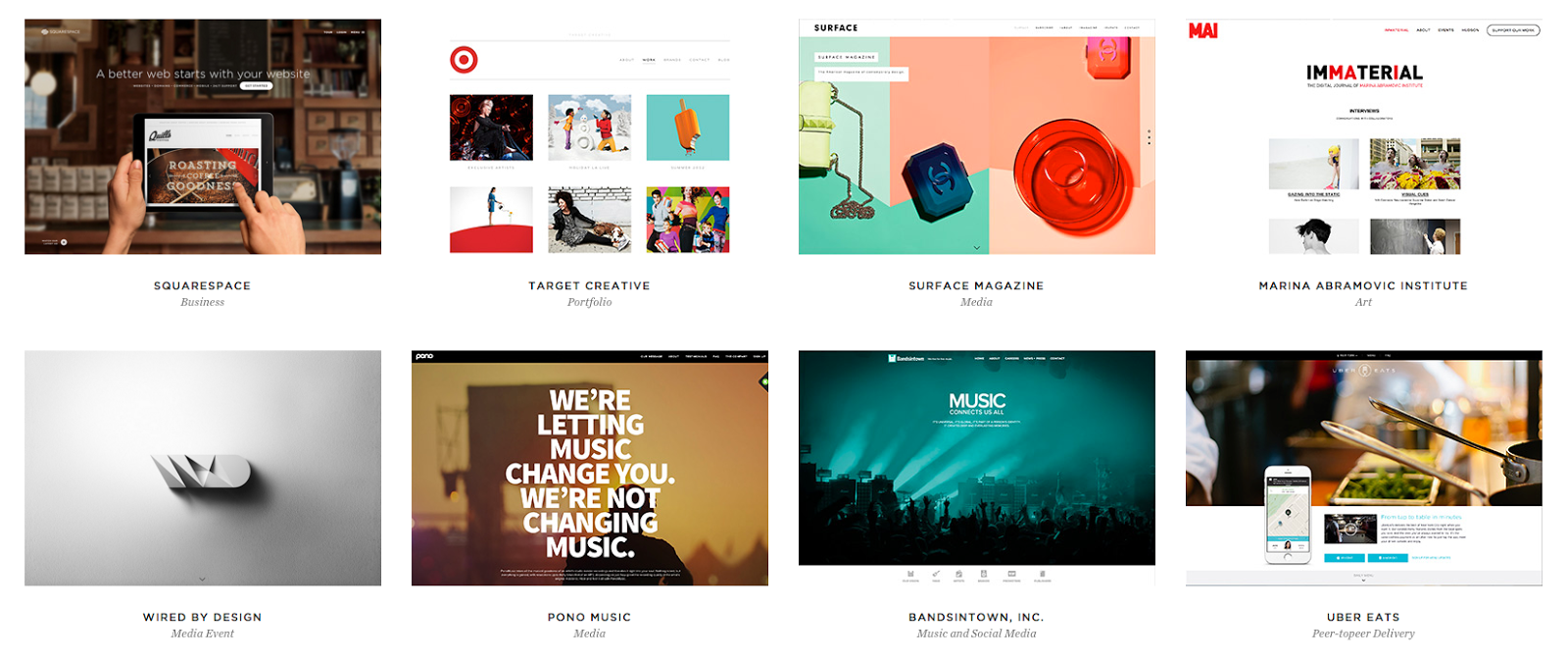
These case studies serve two purposes: they show other people using your product which provides social proof, and they also give your customers more ideas on how to use your product.
We use Sumo case studies to show how our customers have increased their landing page conversion by 70%, or added $82,125 to their annual revenue. In both cases it helps show people the benefits of using the product, as well as give them ideas on new ways to take advantage of it.
Tips for Using Case Studies
- More depth than breadth. The point of a case study is to tell a story, so focus on telling a great story more than on trying to tell a ton of them.
- Give them ideas. Make sure that your case studies show a number of different ways to use your product. A potential customer might not realize that you can help them until they see the right case.
- Make it visual. Since it’s a story, make sure you have strong images to go with it. If you can show a picture of who was the subject in the case, do it!
- Show impact. Don’t just say “it was helpful,” put numbers behind it! For example, “Get 2,239 email subscribers” is much more compelling than “Get more email signups.”
10. FOMO: The Fear of Missing Out
You can leverage your social proof even more if you can convince potential customers that there’s a party going on that they might not get access to.
Few people do this better than Ramit Sethi of I Will Teach You to Be Rich. Look at everything going on in this landing page:

First, he has the social proof: “New York Times Bestseller.” Then, he hits you with the FOMO: “I don’t want to cut into book sales, so get it now before I come to my senses and take this down.”
See how that makes you feel? You want to take action right now! He does the same in his emails. First, he shows you some case studies and testimonials like we talked about before:
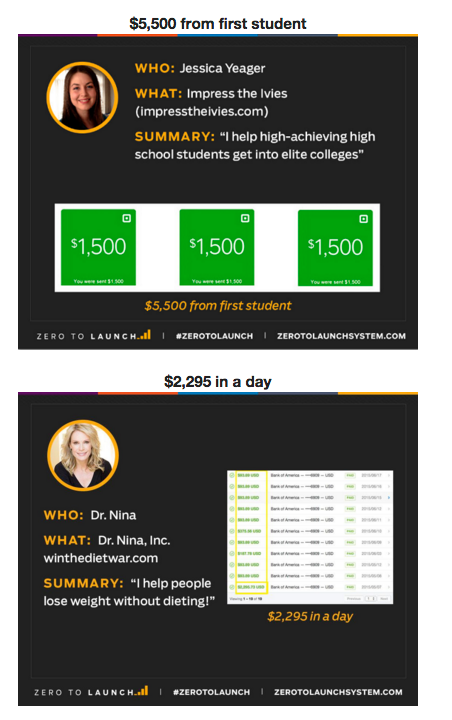
Then after you’ve seen the social proof… he throws in the FOMO:

So here’s the question: How can you power-up your social proof by incorporating some fear of missing out? How can you show that there’s a party going on… and everyone should want to join it right now?
Tips for Using FOMO:
- Add deadlines. Make a consequence for what happens if people don’t act immediately. This could be a price raise, lost bonuses, or just the fact that they’ll regret not starting sooner.
- Show other people who acted: Having case studies and testimonials from people who didn’t waste time taking action is the core of this social proof succeeding. Make sure the testimonials emphasize why people should act now instead of later.
11. Social (Media) Proof
Another method for incorporating more social proof that you might try is drawing on your Twitter, Facebook, Instagram, and other social media accounts to show what people are saying about you out in the real world.
This is another form of testimonial or review, but since it’s coming from a platform outside of your website, there’s an extra degree of trust associated with it.
Depending on how bold you want to be with it, you could feature EVERYTHING (unfiltered) or just select a few choice tweets and pictures that fit the image you want to convey. The second one is usually much safer, since you have no idea what will show up in the first case.
For example, on Anum Hussain’s personal site (Senior Growth Marketer at HubSpot), she features a few tweets from reputable sources commenting on her presentations and growth skills:

Or if you go to the homepage of Couraj (lifestyle brand for people on a courageous journey), you can see some pictures people took on Instagram that they tagged Couraj in:
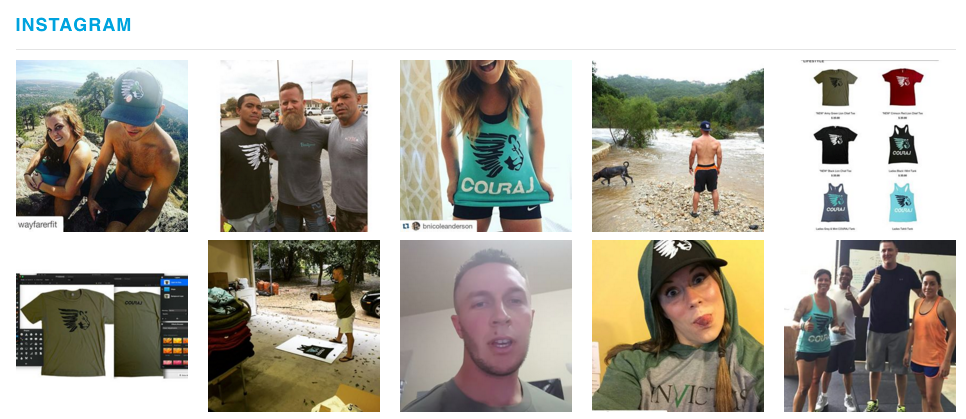
If you have active social media sites that represent your brand, then consider incorporating some of the great testimonials that you’re getting through them into your home page or product pages.
You can even do a fusion, by using your social media to promote your social proof and finding social proof through social media. ModCloth does this with their “Style Gallery” where they feature pictures of women wearing their outfits from social media, and in turn share those photos on the ModCloth social media accounts:

Tips for Using Social (Media) Proof
- Make it relevant. Don’t just throw up any tweet or picture that mentions you, make sure it represents your brand and encourages what you want to happen on your site.
- Use influencers. In Anum’s case, she has some big names tweeting about her, which adds even more social proof to the tweets.
- Keep it diverse. With a diversity of tweets, pictures, pins, etc. you are much more likely to have at least one that a potential new customer resonates with.
- Show the shares. The simplest way to show social media proof? Just show how often something as been shared using the right sharing plugin.
12. Rankings
When I’m trying to find a new place I want to eat for dinner, the first thing I do is open up Foursquare.
Why? Because I don’t just want to go to any taco place… I want to go to one of the top 10 in Austin.
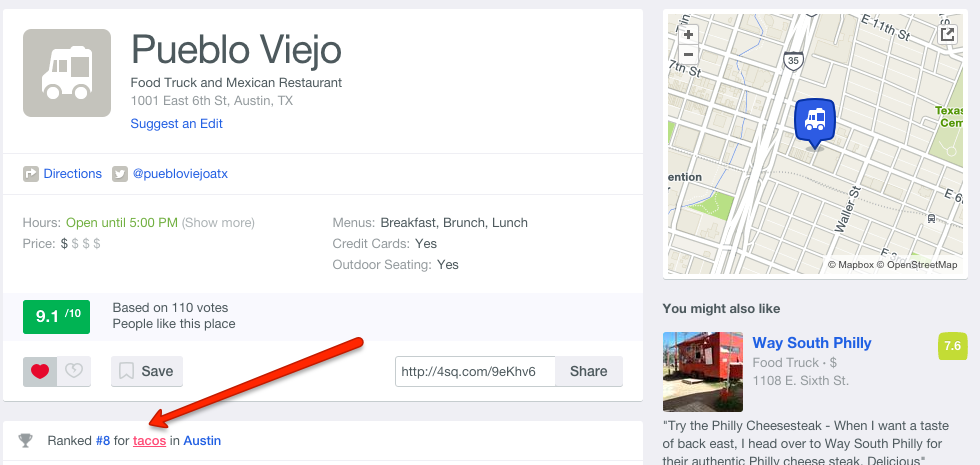
Whatever industry you’re in, being ranked highly within it in some capacity is a strong indicator of your quality.
This is part of the power of a site like Product Hunt. If you can say that you were #1 on Product Hunt the day you launched that carries a lot of weight in the tech world.
On top of that, the better you’re ranked there the more traffic you get from the site, and the more impressed people will be with you when they see you on there in the future.
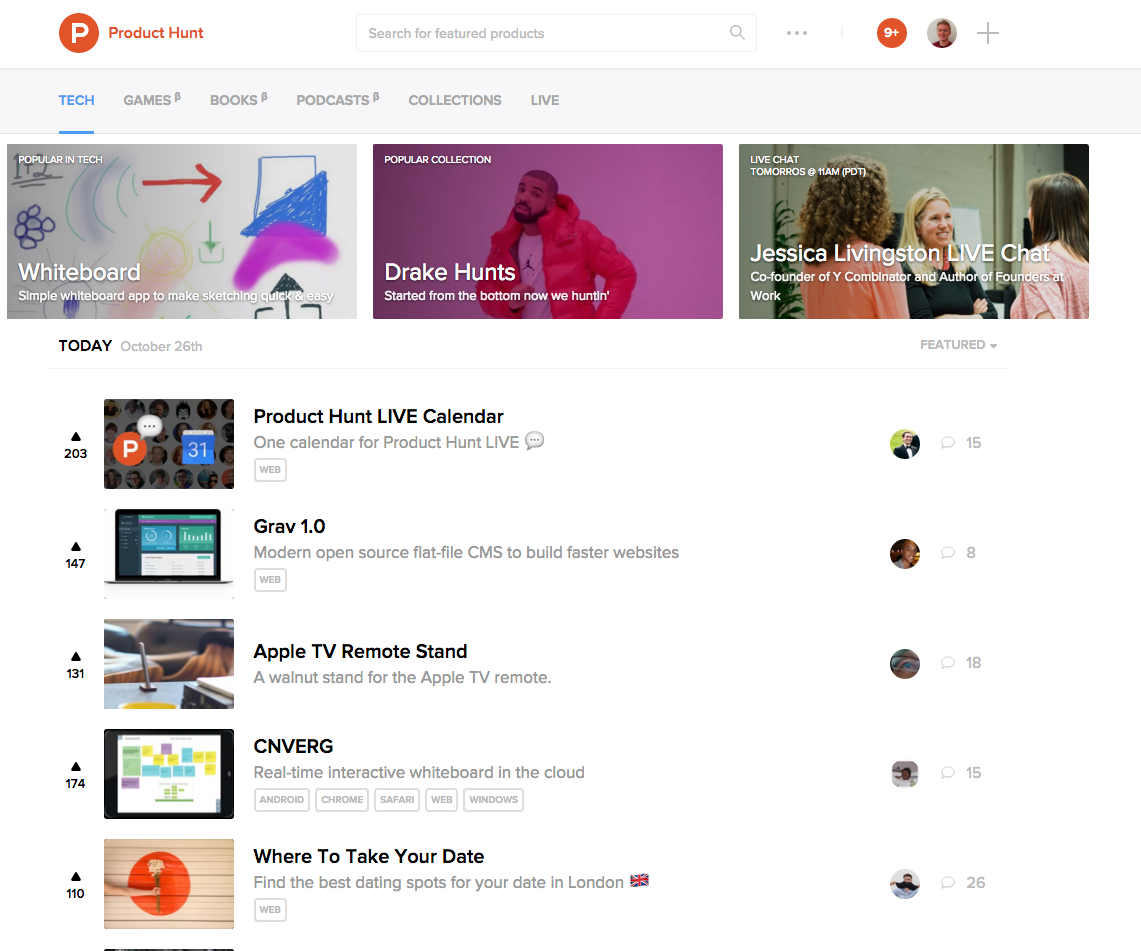
Tips for Using Rankings:
- Only use good ones (obviously). Just focus on the good, everyone has their haters.
- The more reputable, the better. Getting ranked in a New York Times article has a lot more sway than on a random blog. Aim high.
- Build relationships to get featured. If you want to be featured in “top 10” lists from bloggers in your niche, build relationships with them! You want to be at the top of their mind when they start making a best-of list.
13. Integrations and Platforms
Last, but certainly not least, one way to show social proof as a product is to show what other products you integrate with, or how widely your platform is used by other people.
The benefit here is similar to the expert endorsement. When people see that your product is being used by other popular products, there’s a Halo effect that spills over and gives you more credibility.
A random product that can help you rank on Google? Meh.
The site that Airbnb uses to rank on Google? Okay now I’m interested.
We do this by showing the email marketing tools that we integrate with on our homepage at Sumo.com:
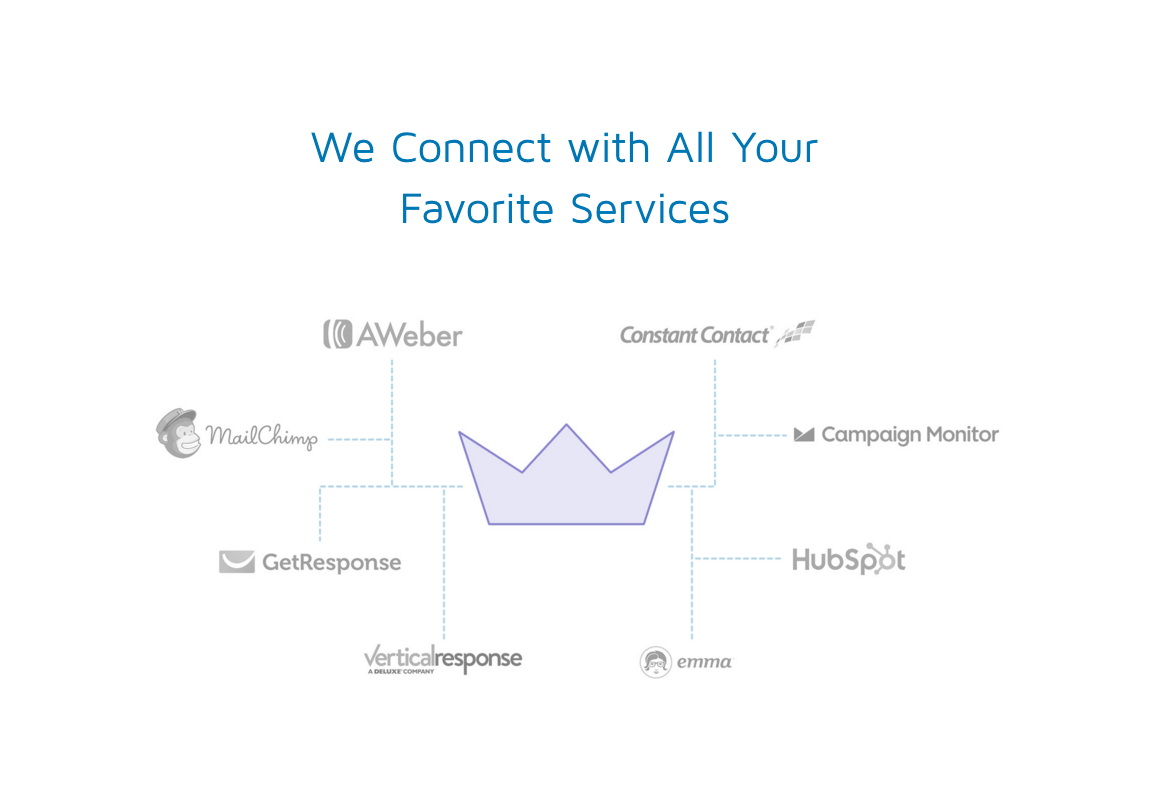
When someone first shows up, maybe they don’t know who we are, but they’ve heard of or used MailChimp or AWeber or Constant Contact, and that lends us extra credibility.
You can see a similar strategy at play on the homepage for WordPress. If you scroll to the bottom, you find out that 24% of the Internet runs on WordPress.

That’s no joke too, it’s true. If a solid quarter of the Internet is using WordPress as a platform to build their sites… maybe you should to.
The third way to use this kind of social proof is to feature the big-name brands that are using your product.
For example, on the homepage for NayTev (a social sharing optimization company), you see that their product is used by TechCrunch among others:
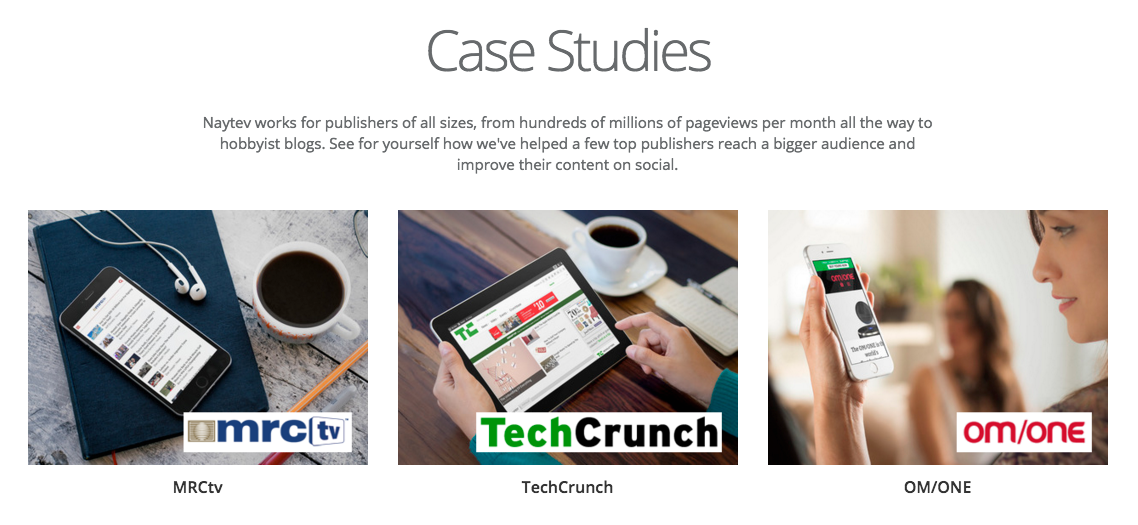
If you were on the fence about whether or not it would be a good product for you, knowing that massive publications are using it is a strong indicator of quality.
Tips to Using Integrations and Platforms:
- List everyone your product integrates with. If applicable, have a dedicated page that shows all of your integration partners, and then feature the best ones on your homepage.
- Be listed elsewhere. If your product is being used by, or integrated with other products, get them to include you in their list of integrations in order to get some of their customers yourself.
Your Turn
It’s time to take full advantage of social proof on your site.
Remember the guide from the beginning? I’m going to reiterate it here:
- Save a link to this article so you can come back and reference it later.
- Pick one or two of the 13 types of social proof that look interesting to you.
- See how that type of social proof might fit into parts of your site. To start, look at your most important call to action. That could be getting their email address, getting them to buy, or getting them to share. Is there social proof attached to it? No? Then add it.
- Track how adding this social proof affects your conversion rates and your success towards your goal.
- Come back to find your next type of social proof to try.
And finally, post in the comments letting me know your plan to increase social proof on your site, and if you have any ideas that we didn’t include here!
Add A Comment
VIEW THE COMMENTS